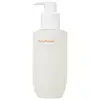What's inside
What's inside
 Key Ingredients
Key Ingredients

 Benefits
Benefits

 Concerns
Concerns

 Ingredients Side-by-side
Ingredients Side-by-side

C12-15 Alkyl Benzoate
AntimicrobialPentaerythrityl Tetraethylhexanoate
EmollientIsopropyl Palmitate
EmollientPentaerythrityl Tetraisostearate
EmollientCaprylic/Capric Triglyceride
MaskingPEG-20 Glyceryl Triisostearate
EmollientPEG-8 Isostearate
EmulsifyingCocos Nucifera Oil
MaskingDextrin Palmitate
EmulsifyingParfum
MaskingLimonene
PerfumingGlyceryl Behenate/Eicosadioate
EmollientCoco-Caprylate/Caprate
EmollientSqualane
EmollientLinalool
PerfumingWater
Skin ConditioningButylene Glycol
HumectantPrunus Armeniaca Kernel Oil
MaskingPinus Koraiensis Seed Oil
PerfumingSesamum Indicum Seed Oil
EmollientCamellia Japonica Seed Oil
EmollientCoix Lacryma-Jobi Ma-Yuen Seed Extract
Skin ConditioningCitrus Unshiu Peel Extract
MaskingCastanea Crenata Shell Extract
Skin ConditioningSpirodela Polyrhiza Extract
Skin ConditioningPrunus Mume Seed Extract
Skin ConditioningNelumbo Nucifera Seed Extract
AntimicrobialC12-15 Alkyl Benzoate, Pentaerythrityl Tetraethylhexanoate, Isopropyl Palmitate, Pentaerythrityl Tetraisostearate, Caprylic/Capric Triglyceride, PEG-20 Glyceryl Triisostearate, PEG-8 Isostearate, Cocos Nucifera Oil, Dextrin Palmitate, Parfum, Limonene, Glyceryl Behenate/Eicosadioate, Coco-Caprylate/Caprate, Squalane, Linalool, Water, Butylene Glycol, Prunus Armeniaca Kernel Oil, Pinus Koraiensis Seed Oil, Sesamum Indicum Seed Oil, Camellia Japonica Seed Oil, Coix Lacryma-Jobi Ma-Yuen Seed Extract, Citrus Unshiu Peel Extract, Castanea Crenata Shell Extract, Spirodela Polyrhiza Extract, Prunus Mume Seed Extract, Nelumbo Nucifera Seed Extract
 Reviews
Reviews

Ingredients Explained
These ingredients are found in both products.
Ingredients higher up in an ingredient list are typically present in a larger amount.
This ingredient is an emollient, solvent, and texture enhancer. It is considered a skin-softener by helping the skin prevent moisture loss.
It helps thicken a product's formula and makes it easier to spread by dissolving clumping compounds.
Caprylic Triglyceride is made by combining glycerin with coconut oil, forming a clear liquid.
While there is an assumption Caprylic Triglyceride can clog pores due to it being derived from coconut oil, there is no research supporting this.
Learn more about Caprylic/Capric TriglycerideCocos Nucifera Oil is obtained from the kernels of the coconut fruit. In other words, this is coconut oil.
Coconut Oil is rich in fatty acids with lauric acid making up the majority of these. It also contains linoleic acid. Due to this high fatty acid content, coconut oil helps trap moisture and soften skin.
Despite being antibacterial, coconut oil may not be great for acne-prone skin. It is comedogenic and may clog pores. This ingredient may not be safe for malassezia or fungal acne.
Note: Coconut Oil should not replace your sunscreen for UV protection. Studies show it only blocks about 20% of UV.
This oil is non-volatile and has a light scent.
The term 'fragrance' is not regulated in many countries. In many cases, it is up to the brand to define this term. For instance, many brands choose to label themselves as "fragrance-free" because they are not using synthetic fragrances. However, their products may still contain ingredients such as essential oils that are considered a fragrance.
Learn more about Cocos Nucifera OilIsopropyl Palmitate is a texture enhancer and emollient. It is an ester of isopropyl alcohol and palmitic acid.
Palmitates are emollients. Emollients help keep your skin soft and smooth by creating a barrier that traps moisture in.
When added to cosmetics, Isopropyl Palmitate creates a silky texture and improves spreadability.
Isopropyl Palmitate may not be fungal acne safe. It can worsen acne prone skin.
Learn more about Isopropyl PalmitateLinalool is a fragrance and helps add scent to products. It's derived from common plants such as cinnamon, mint, citrus, and lavender.
Like Limonene, this ingredient oxidizes when exposed to air. Oxidized linalool can cause allergies and skin sensitivity.
This ingredient has a scent that is floral, spicy tropical, and citrus-like.
Learn more about LinaloolParfum is a catch-all term for an ingredient or more that is used to give a scent to products.
Also called "fragrance", this ingredient can be a blend of hundreds of chemicals or plant oils. This means every product with "fragrance" or "parfum" in the ingredients list is a different mixture.
For instance, Habanolide is a proprietary trade name for a specific aroma chemical. When used as a fragrance ingredient in cosmetics, most aroma chemicals fall under the broad labeling category of “FRAGRANCE” or “PARFUM” according to EU and US regulations.
The term 'parfum' or 'fragrance' is not regulated in many countries. In many cases, it is up to the brand to define this term.
For instance, many brands choose to label themselves as "fragrance-free" because they are not using synthetic fragrances. However, their products may still contain ingredients such as essential oils that are considered a fragrance by INCI standards.
One example is Calendula flower extract. Calendula is an essential oil that still imparts a scent or 'fragrance'.
Depending on the blend, the ingredients in the mixture can cause allergies and sensitivities on the skin. Some ingredients that are known EU allergens include linalool and citronellol.
Parfum can also be used to mask or cover an unpleasant scent.
The bottom line is: not all fragrances/parfum/ingredients are created equally. If you are worried about fragrances, we recommend taking a closer look at an ingredient. And of course, we always recommend speaking with a professional.
Learn more about ParfumPeg-20 Glyceryl Triisostearate comes from Isostearic Acid and glycerin.
It is an emollient, emulsifier, and gentle cleanser. As an emollient, it helps trap moisture to keep skin soft and hydrated. Emulsifiers help prevent ingredients from separating.
This ingredient is common in oil-based products. This is because it helps oil-ingredients be easily washed away without leaving a residue.
Peg-20 Glyceryl Triisostearate may not be fungal-acne safe.
Learn more about PEG-20 Glyceryl Triisostearate